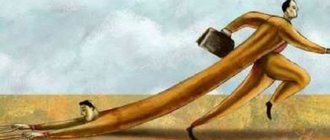Every year the exact sciences are developing more and more, and with them others are improving. Psychologists almost every day introduce new terms into human everyday life. Especially many words have the ending “phobia”. A phobia is a fear or apprehension, rejection or dislike of something. It turns out that people are not only afraid of heights or the dark, but also of things that seem illogical to be afraid of. For example, someone is genuinely scared by the number 13, people of other races, or representatives of gay people. A very popular question: “Homophobes - who are they?” What kind of people are these, what do they fear, avoid or do not welcome?
Etymology and semantics of the term
What does "homophobe" mean? It should be noted that this word is of Greek origin and literally means the following: “homo” is the same, and “phob” (Phobos) is fear of something. Consequently, people suffering from this “disease” show a negative reaction to any homosexual manifestations, no matter in what form.
American psychologist Georges Weinberg was able to give a one-word designation for this phenomenon in his book in the 70s. Since then, this term has been actively used by scientists in various fields of activity and scientific institutions in various documentation and literature.
Regardless of the true meaning of the word “homophobe,” it is most often used to define people who experience negative emotions towards representatives of gay people.
Causes of homophobia
Homophobia is a hostile attitude towards representatives of these minorities, being a very common phenomenon, often leading to insults and violence, institutionalized homophobia, and discrimination against people of homosexual orientation by society.
The result of the spread of homophobia is non-compliance with the rights of minorities, the emergence of obstacles in the occupation of certain positions by lesbians and gays, as well as bans on holding processions and rallies. Many opponents of same-sex sexual relations argue that attitudes towards manifestations of homosexuality are directly related to ideas about the norm and therefore are not something reprehensible or abnormal. Many of the opponents of same-sex sexual relations object to the use of the term homophobia, attributing it to an ideological cliché, which has led to a proposal to replace this term with a neutral term - homonegativism. At the same time, an opinion emerged that homophobia is a form of xenophobia, since it means fear of those who stand out from the general mass. Opponents of homosexuality attribute this condition to a sin, a clinical disorder, and a violation of public morality.
The line between rejection and homophobia
In fact, making a clear distinction between quiet rejection of homosexuals and open homophobia is difficult and even impossible. These states can flow into each other, take one form or another, or not manifest themselves at all.
It is believed that heterosexual individuals are not entirely comfortable with homosexual relationships. Girls kissing, guys hugging - “normal” society does not accept these relationships, since same-sex love does not produce offspring. It is reproduction that is one of the basic instincts that drives humanity forward along the road of development into the future. Since homosexual contacts do not allow one to become pregnant and give birth to a child, this means that this is an “incorrect relationship.”
Psychological aspects of homophobia
It is a well-known fact: some people are calm about the fact that people of the same sex can be attracted to each other, while others vehemently argue that this is impossible. Why is this and what's the catch? The question arises: “Homophobes – who are they? Are these people with secret desires masquerading as “normal” heterosexuals?”
There is a very interesting version - the more active and violent a homophobe behaves, the more he wants to divert attention from himself and seem “normal.” As Sigmund Freud wrote back in his time, every man is a latent homosexual. Perhaps this is what motivates people to behave belligerently and aggressively towards open same-sex love.
How to fight homophobia?
How to get rid of homophobia is a complex question that arises at the level of the state and each individual person. If we take the struggle of society against homophobia, then it is gradually being introduced into the system through the development of tolerance. An individual person, if he suffers from homophobia, it is important to understand the reasons why there is such a strong negative reaction towards gays: there is no acceptance of one’s homosexuality or there is no understanding that all people are different, and same-sex love also has the right to exist.
Homophobic stars
Any social phenomenon is divided into those who are “for” and those who are “against” and same-sex love, the organization of sexual minorities more often causes attacks of homophobia in people than the acceptance that everyone is different. Among famous people working in creative environments, there are also many who, although they do not openly shout that he or she hates homosexuals, show their hostility. Homophobic celebrities:
- Eminem. The famous rapper has repeatedly spoken hostilely about gays and lesbians in his songs.
- Mel Gibson. The actor, known for his piety and religiosity, long ago broke off his relationship with his gay brother, and because of obscene statements addressed to sexual minorities, he got into trouble many times.
- Chris Brown. Rihanna's ex-boyfriend doesn't like gay people and uses the word "gay" as an insult.
- Paris Hilton. She often gets into unpleasant situations due to the fact that on her blog she insults homosexuals, giving them the nickname “monkeys and homosexuals”, when her telephone conversation, recorded by a taxi driver, about how gays are carriers of infection got into the media, the organization of the fight for sexual rights minorities demanded that Paris apologize for her words.
- Alec Baldwin. The actor is known for his hateful homophobic remarks against gay politicians.
Internal homophobia
It is impossible not to mention another type of homophobia, which is called internal. It has not yet been established why men or women become adherents of same-sex relationships. You can blame childhood trauma, sexual abuse, fashion influences. However, millions of gays and lesbians surveyed admit that they had a completely normal childhood with loving parents and traditional entertainment. Why does a “failure in the program” occur and a person begins to be attracted to representatives of the same sex? This is a great mystery.
Given the general excitement about the topic of homosexuality, many homosexuals feel disgusted by same-sex love. This is a very complex topic in psychology, the reason for which, of course, is public opinion. It is this that often shapes our attitudes towards certain phenomena, and therefore one of them is internal homophobia. A gay or lesbian does not admit to himself or the world his desires, but actively promotes normal heterosexual relationships. Such an atypical homophobe is very unhappy, since happiness is determined by a person’s ability to be who he is. These people constantly experience remorse, lower their self-esteem, and also live in fear of exposure.
The term "homophobia" in psychology
Homophobia has long been studied by specialists in various fields, in particular psychologists and psychiatrists.
Homophobia and its limits
According to psychologists, there is no clear line between homophobia and negative attitudes towards homosexuals. Sometimes the term is associated not only with the declaration of a given position, but also with an active struggle and purposeful manifestation of negative emotions.
The expansion of the term from the professional sphere to the masses has become the reason for identifying homophobia with any negative manifestations regarding the minorities in question, while most researchers do not distinguish between an emotional reaction and an intellectual rejection of same-sex relationships. This opinion was expressed by Ricketts and Hudson in a 1980 paper and shared with a clearer distinction between homonegativism and homophobia itself.
Homonegativism is represented by judgments regarding the morality of the phenomenon in question and actions based on social principles, preferences and ideas.
Homophobia is a truly phobic manifestation with such phenomena as fear, disgust and anxiety directly during personal communication with representatives of same-sex minorities.
Herek in 1991 was against the use of the concept in question and proposed the term "anti-homosexual prejudice" because it cast a shadow on the individual, when such attitudes should be perceived as a cultural influence rather than a personal fault.
Stereotypes in the cultural perception of homophobia
It just so happened historically that there are regions that are more loyal and tolerant towards homosexuals. And there are countries that do not accept open manifestations of same-sex contacts even in today’s progressive times. To understand how things stand with homophobia in the modern world, think where same-sex marriage is legalized, and where feminine men can still be mocked and ridiculed.
It is believed that Western and European countries are very tolerant of homosexuality. Gays, lesbians, transvestites and bisexuals are not afraid and do not hide, but on the contrary, they hold gay pride parades and legitimize their relationships at the state level.
The Slavs, to this day, are recognized by world opinion as the greatest enemies of homosexuality. There is even such a concept - “Russian homophobes”, that is, people who treat same-sex contacts most aggressively and maliciously are meant. This is not at all accidental - our history has always condemned “sodomy”, and in tsarist times people were impaled for homosexuality.
At the same time, it is documented that in Ancient Greece and Rome, courageous warriors did not hesitate to show sympathy for their fellow craftsmen, and this in no way affected society’s attitude towards them. Many famous writers, musicians and artists openly admitted their bisexual or homosexual inclinations, and today openly gays and lesbians are super popular designers, directors, presenters and performers.
“Same-sex love” is the norm in the animal world
Unlike people, animals do not have sociocultural prejudices, and therefore freely express their homo- and bisexual inclinations. According to research by Canadian biologist Bruce Bagemil, homosexual behavior is observed in about one and a half thousand species - from spiny-headed worms to primates. Thus, the gay elephant named Niño, who lives in the Polish zoo, is widely known, as are Roy and Silou, penguins from the New York Central Zoo. In addition, homosexuality is very common among swans (yes, yes, symbols of love and fidelity!) - almost 25% of couples are males alone. At the same time, homosexual relationships in animals are not built only on instincts and are not reduced to banal mating: like people, same-sex representatives of the fauna look after each other and create “families.”
Thus, if nature itself has nothing against gays, then why is the crown of its creation - man - so hostile?
Homophobia in countries around the world
Despite attempts to establish the most tolerant attitude towards homosexuals in the world, adherents of same-sex relationships are constantly attacked.
For example, 9 out of 10 gays in America openly say that they have heard insults directed at them, and a third admit that they have experienced physical violence from homophobes. Statistics also confirm that even at school age, children can hear up to 30 homophobic statements a day - from peers, teachers and adults.
Life is very difficult for homosexuals in Muslim countries, where there is real hunting and persecution of openly gays and lesbians. During bullying, gay people not only hear insults and threats, but can be severely beaten and even killed. Examples of such countries are Iraq and Iran.
Things are no better in Israel. The incident that occurred in 2005 at the gay pride parade is very well known to the world community. Then another rally was held on the streets of the city - a parade of opponents of gay people. They carried banners declaring that homosexuality is a disease and threw containers of feces and urine at gay pride supporters.
It turns out that homophobes are not so harmless. Who are these - not murderers and savages, ready to tear to pieces dissidents?
Homosexuality and homophobia on television
Since television has become our constant companions, best friends and news providers, public opinion has been shaped by shows, serials and advertising. Perhaps it was thanks to television that “normal” people around the world realized that there are so many homosexuals that it is better to accept them than to reject them. In addition, many popular idols do not hide their orientation and in fact turn out to be homosexuals. But there are no fewer opponents of same-sex love, open and hidden homophobes than there are supporters, and maybe even more. Books, films, and songs condemn same-sex attraction, promoting healthy relationships and procreation. In this case, homophobes - who are they? Are they really people fighting for the continuation of the human race on Earth?
Homosexuality is not a disease
According to public opinion polls conducted by the Levada Center, 74% of residents of our country consider homosexuality to be a disease, a consequence of mental trauma or promiscuity, and only 15% - simply a sexual orientation.
Sigmund Freud
Scenario of your happy life
A free online marathon that will help you find financial stability, find your calling, and make your life bright and eventful!
Become a member
However, Sigmund Freud also argued that homosexuality cannot be considered a disease - it is only a type of sexual function. Among domestic scientists, the first to take the position “homosexuality is not a disease” was the famous sexologist Igor Kon, author of the book “Moonlight at Dawn. Faces and masks of same-sex love. Diagnosis of fate or the fate of a diagnosis” (2003). The fact that homosexuality is not a mental personality disorder is confirmed by the fact that more than 20 years ago, in 1990, it was excluded from the international classification of diseases of the World Health Organization. Following the WHO decision, homosexuality was no longer considered a pathology by many countries around the world, including Russia.
In turn, homophobia is also not considered a mental illness (this term was introduced by psychologist George Weinberg, and it has come into widespread use since the mid-70s), however, like any phobia, it is characterized by disgust, anger, aggression and other dangerous negative reactions towards the object of fear.
Endless fight
The confrontation between different countries, cultures, and religions will last forever. People sometimes lack simple human understanding in order to decide for themselves - everyone in this world has the right to their opinion, their views and their choice. Homosexuality, whatever it is, is just another difference between people.
And there is no need to speculate whether it is a disease, a psychological deviation or a feature bestowed from above. Awareness is the best way out in this situation. Live, be happy, and don’t interfere with other people’s happiness, no matter who they are. Or joyfully stick the homophobic flag into your defeated “enemies,” exclaiming that you are fighting for the purity of a race or nation. But this struggle is no better than Hitler’s war against the Jews, just as senseless and bloody.











